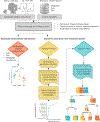Salivary Metabolites are Promising Non-Invasive Biomarkers of Hepatocellular Carcinoma and Chronic Liver Disease
- PMID: 34541549
- PMCID: PMC8447405
- DOI: 10.1002/lci2.25
Salivary Metabolites are Promising Non-Invasive Biomarkers of Hepatocellular Carcinoma and Chronic Liver Disease
Abstract
Background: Hepatocellular carcinoma (HCC) is a leading causes of cancer mortality worldwide. Improved tools are needed for detecting HCC so that treatment can begin as early as possible. Current diagnostic approaches and existing biomarkers, such as alpha-fetoprotein (AFP) lack sensitivity, resulting in too many false negative diagnoses. Machine-learning may be able to identify combinations of biomarkers that provide more robust predictions and improve sensitivity for detecting HCC. We sought to evaluate whether metabolites in patient saliva could distinguish those with HCC, cirrhosis, and those with no documented liver disease.
Methods and results: We tested 125 salivary metabolites from 110 individuals (43 healthy, 37 HCC, 30 cirrhosis) and identified 4 metabolites that displayed significantly different abundance between groups (FDR P <.2). We also developed four tree-based, machine-learning models, optimized to include different numbers of metabolites, that were trained using cross-validation on 99 patients and validated on a withheld test set of 11 patients. A model using 12 metabolites -octadecanol, acetophenone, lauric acid, 1-monopalmitin, dodecanol, salicylaldehyde, glycyl-proline, 1-monostearin, creatinine, glutamine, serine and 4-hydroxybutyric acid- had a cross-validated sensitivity of 84.8%, specificity of 92.4% and correctly classified 90% of the HCC patients in the test cohort. This model outperformed previously reported sensitivities and specificities for AFP (20-100ng/ml) (61%, 86%) and AFP plus ultrasound (62%, 88%).
Conclusions and impact: Metabolites detectable in saliva may represent products of disease pathology or a breakdown in liver function. Notably, combinations of salivary metabolites derived from machine-learning may serve as promising non-invasive biomarkers for the detection of HCC.
Keywords: Metabolomics; cirrhosis; liver cancer; machine learnings; risk factor.
Conflict of interest statement
Competing Interests D.M.R. has an equity stake in Interpares Biomedicine, LLC. D.M.R., F.A., D.S.A hold intellectual property related to the detection of hepatocellular carcinoma.
Figures




Similar articles
-
Salivary miRNAs as non-invasive biomarkers of hepatocellular carcinoma: a pilot study.PeerJ. 2022 Jan 5;10:e12715. doi: 10.7717/peerj.12715. eCollection 2022. PeerJ. 2022. PMID: 35036096 Free PMC article.
-
Characterization of Salivary and Plasma Metabolites as Biomarkers for HCC: A Pilot Study.Cancers (Basel). 2023 Sep 12;15(18):4527. doi: 10.3390/cancers15184527. Cancers (Basel). 2023. PMID: 37760495 Free PMC article.
-
Validation of a Novel Multitarget Blood Test Shows High Sensitivity to Detect Early Stage Hepatocellular Carcinoma.Clin Gastroenterol Hepatol. 2022 Jan;20(1):173-182.e7. doi: 10.1016/j.cgh.2021.08.010. Epub 2021 Aug 13. Clin Gastroenterol Hepatol. 2022. PMID: 34391922
-
Metabolomics biomarkers of hepatocellular carcinoma in a prospective cohort of patients with cirrhosis.JHEP Rep. 2024 May 15;6(8):101119. doi: 10.1016/j.jhepr.2024.101119. eCollection 2024 Aug. JHEP Rep. 2024. PMID: 39139459 Free PMC article.
-
Alpha-Fetoprotein (AFP) and AFP-L3 Is Most Useful in Detection of Recurrence of Hepatocellular Carcinoma in Patients after Tumor Ablation and with Low AFP Level.Viruses. 2022 Apr 8;14(4):775. doi: 10.3390/v14040775. Viruses. 2022. PMID: 35458505 Free PMC article. Review.
Cited by
-
Circulating Gut Microbe-Derived Metabolites Are Associated with Hepatocellular Carcinoma.Biomedicines. 2024 Aug 26;12(9):1946. doi: 10.3390/biomedicines12091946. Biomedicines. 2024. PMID: 39335460 Free PMC article.
-
Spermine accumulation via spermine synthase promotes tumor cell proliferation in head and neck squamous cell carcinoma.BMC Cancer. 2025 Mar 5;25(1):402. doi: 10.1186/s12885-025-13820-x. BMC Cancer. 2025. PMID: 40045286 Free PMC article.
-
Novel breath biomarkers identification for early detection of hepatocellular carcinoma and cirrhosis using ML tools and GCMS.PLoS One. 2023 Nov 15;18(11):e0287465. doi: 10.1371/journal.pone.0287465. eCollection 2023. PLoS One. 2023. PMID: 37967076 Free PMC article.
-
Novel machine learning models outperform risk scores in predicting hepatocellular carcinoma in patients with chronic viral hepatitis.JHEP Rep. 2022 Jan 22;4(3):100441. doi: 10.1016/j.jhepr.2022.100441. eCollection 2022 Mar. JHEP Rep. 2022. PMID: 35198928 Free PMC article.
-
Salivary metabolites are promising noninvasive biomarkers of drug-induced liver injury.World J Gastroenterol. 2024 May 14;30(18):2454-2466. doi: 10.3748/wjg.v30.i18.2454. World J Gastroenterol. 2024. PMID: 38764769 Free PMC article.
References
-
- Siegel RL, Miller KD, Jemal A. Cancer statistics, 2020. CA Cancer J Clin. United States; 2020;70:7–30. - PubMed
-
- Forner A, Reig M, Bruix J. Hepatocellular carcinoma. Lancet Lond Engl. England; 2018;391:1301–14. - PubMed
-
- Sun C-A, Wu D-M, Lin C-C, Lu S-N, You S-L, Wang L-Y, et al.Incidence and cofactors of hepatitis C virus-related hepatocellular carcinoma: a prospective study of 12,008 men in Taiwan. Am J Epidemiol. United States; 2003;157:674–82. - PubMed
Grants and funding
LinkOut - more resources
Full Text Sources
